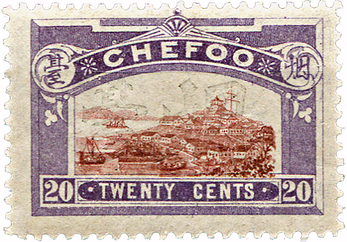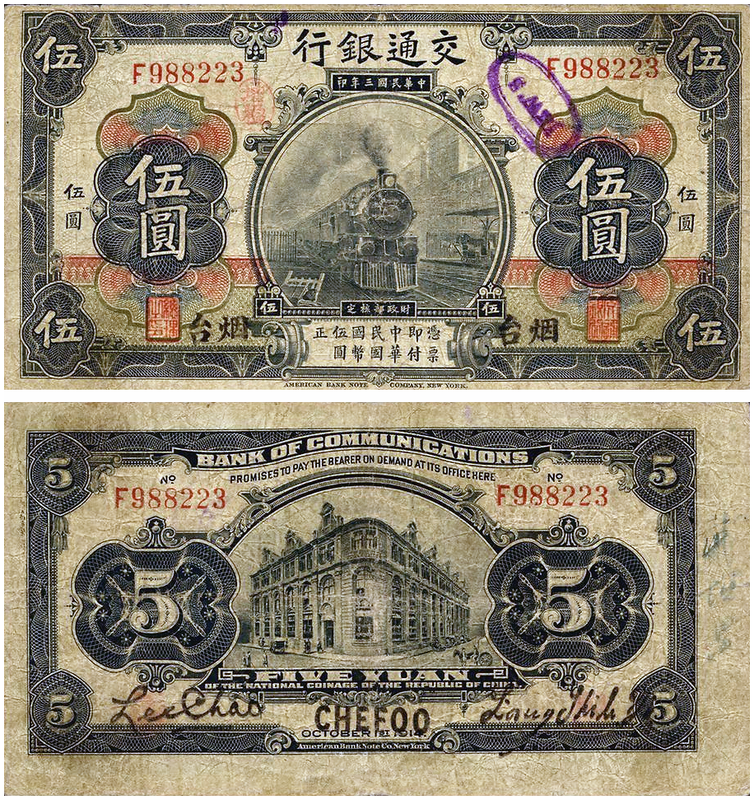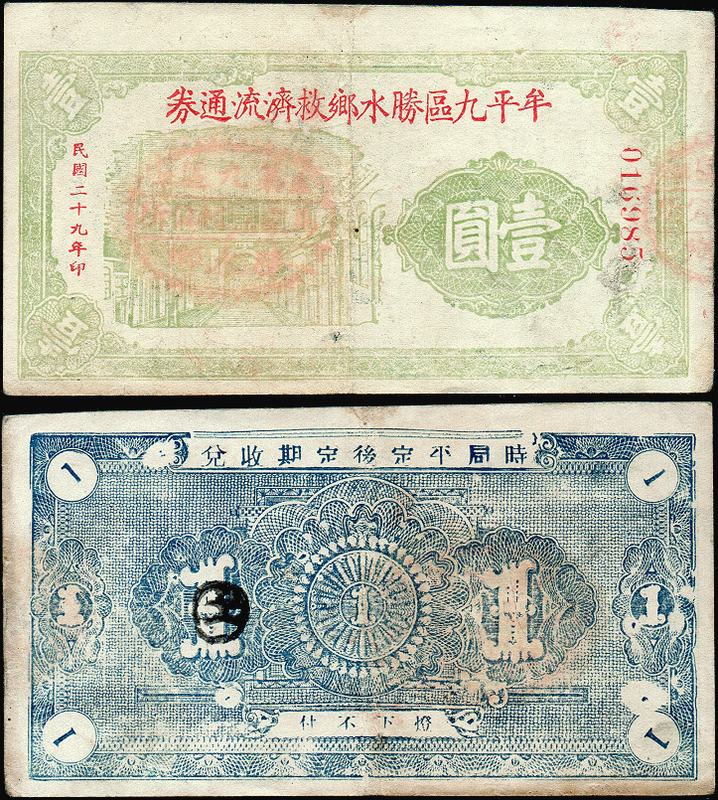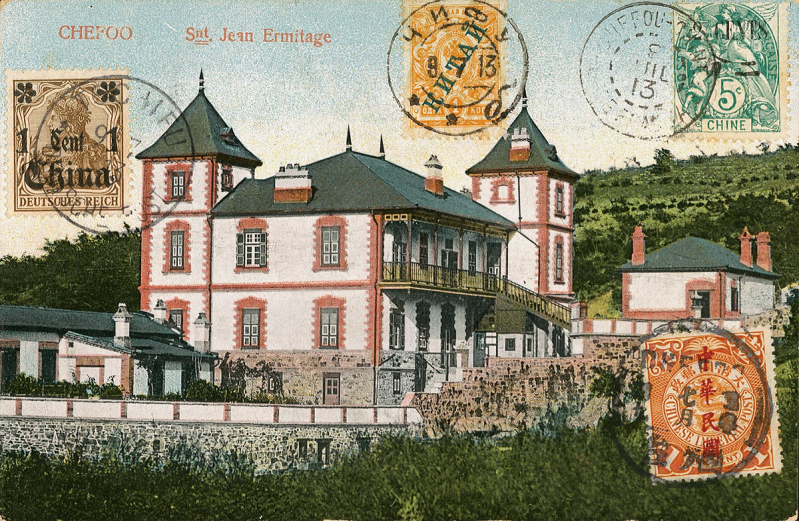|
Chefoo (now known as Yantai) is a seaport on the north coast of Shantung (Shandong) province. The city was traditionally known as Zhifu (Chefoo), which was the name of the island that protects Yantai’s natural deep-water harbour, where a port has been located from early times. The name Yantai (“Beacon Tower”) derives from a lookout beacon built on a hill overlooking the site as part of the 15th-century coastal defense system erected against Japanese pirates.
Later known as Dengzhou, until 1858, Chefoo became an international port - a 'treaty port' - in August 1861, with 17 nations establishing enclaves here; however their were no formal concessions established. |
Numerous foreign traders lived there, and a flourishing trade grew up in the late 19th century, consisting partly of exports of silk, beans, and local produce from Shantung and partly of imports from the West. During 1891–1901 the city’s population almost doubled. Chefoo's commerce was, however, almost ruined by the development of Tsingtau (Qingdao) on the southern coast of the peninsula by the Germans after 1898. By 1904 a rail link connected Tsingtau with Tsinan (Jinan), after which the export trade of Shantung became concentrated at the better port of Tsingtau. As a result, Chefoo and the other ports of northern Shantung stagnated. This probably explains why Chefoo based currency issues - especially by government and other major banks - diminished considerably after the 1920s.
Above: (left) the quayside at Chefoo, c. 1900. (right) a postcard view across the town, showing the numerous western buildings which soon dominated Chefoo. The stamp was issued by the German Post Offices in China - overprinted on a standard German stamp.
|
Left: A Chefoo issued local stamp of 1893.
Chefoo was one of only five cities in which the first stamps of China, the Large Dragons, were issued. In terms of importance in a Local Post context, it only ranked second to Shanghai Local Post, which had a head-start of nearly 30 years, before Chefoo's Local Post’s inception in June 1893. Stamps were subsequently issued in October 1893. China's Imperial Post began operation from 1897, at which point all other issuers were declared unlawful. |
Above left: one of the main streets of Chefoo in August 1926. Above right: Chefoo Harbour in 1909
Since 1949, and especially after 1984, when Yantai was designated one of China’s “open” cities as part of the effort to liberalize economic policy by inviting foreign trade and investment - the city has grown considerably. Industries producing textiles, processed foods, machinery, construction equipment, electronics, instruments and meters, metallurgical products, and auto parts have been established. Wines, tinned foods, wooden clocks, and locks are Yantai’s traditional products, and gold trading and gold working are also important to the city.
The Banknotes
The Bank of China - 中國銀行
|
Little information is readily available for the Bank of China's Chefoo branch. A limited number of series of 1918 notes were issued, followed much later by a now equally scarce issue of 1934 'Shantung' notes overprinted with 'Chefoo' in Chinese and English. Upper right: Bank of China 1918 'Shantung' $5 (SCWPM P52-uncatalogued branch) and $10 (SCWPM P53c) notes overprinted for issue/redemption at Chefoo (issued 1928-1935). Lower right: Shantung 5 Yuan of 1934, overprinted for issue/redemption at Chefoo. (SCWPM P72c). The note depicts important Confucian and Daoist landmarks in Shantung (Shandong) province: the pai-lou gate at the Confucius Estate and Temple, leading to the Confucian cemetery. The back (not shown) depicts a small pailou gate plus Chinese stone carved inscriptions on a rocky slope at Taishan Mountain. |
The Bank of Communications - 交通銀行
There is little information specific to the Chefoo branch of the Bank. Notes of the 1913 and 1914 series were issued by the branch and are now extremely rare. Those of the 1914 series ceased to be issued by the early 1930s. The last named branch issues were of the series of 1927 Shantung notes, which were issued until the mid to late 1930s.
The Hong Kong & Shanghai Banking Corporation 香港上海匯豐銀行
|
Right: A rare late Chinese branch issue of this British colonial bank; a $10 issued at Chefoo on September 1st 1922. A hand-signed note with a depiction of the banks main offices on the back; the Hong Kong branch at left, and the Shanghai branch on the Bund at right. This note does not seem to appear in the SCWPM. |
(Shantung) Mouping 9 Districts Tangquan Township Relief Coupons -
券通流濟救鄉水勝區九平牟 - 牟平九區勝水鄉救濟流通券
券通流濟救鄉水勝區九平牟 - 牟平九區勝水鄉救濟流通券
|
One of many issuers of local government emergency money, most with some ties to the communists. Tangquan village is or was southeast of Mouping (Muping) town, in the district of Muping, now administered by the prefecture-level city of Yantai (Chefoo), Shandong province. Right: 1 Yuan of 1940. Block printed on smooth, fairly robust paper. Better quality than many such issues of this type. The same gatehouse vignette, though with different framing, appears on small commercial issues of Shandong, of the mid 1930s. |
Above left: St Jean Ermitage at Chefoo. Assumedly a French built residence. The postcard is unusual as it carries stamps of the German, French and Russian Post Offices in China, and an overprinted Chinese Empire stamp of the revolutionary period.
Above right: the coastline near Chefoo.
Above right: the coastline near Chefoo.















